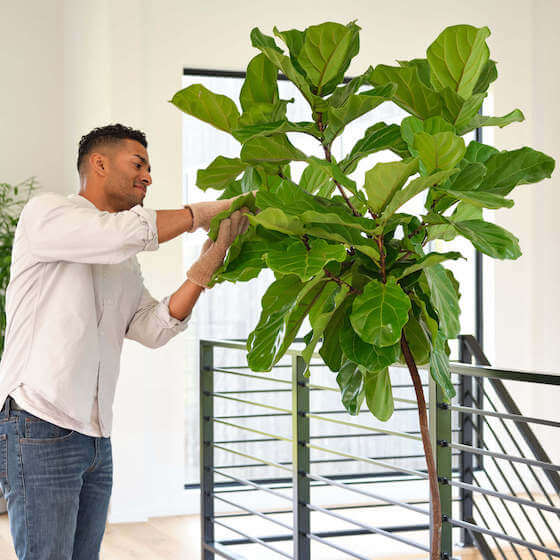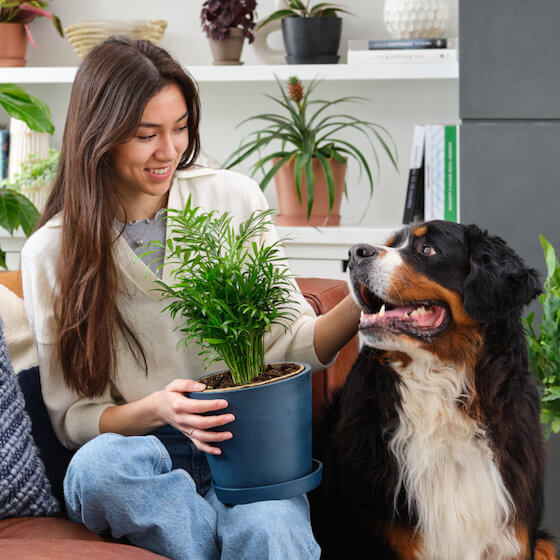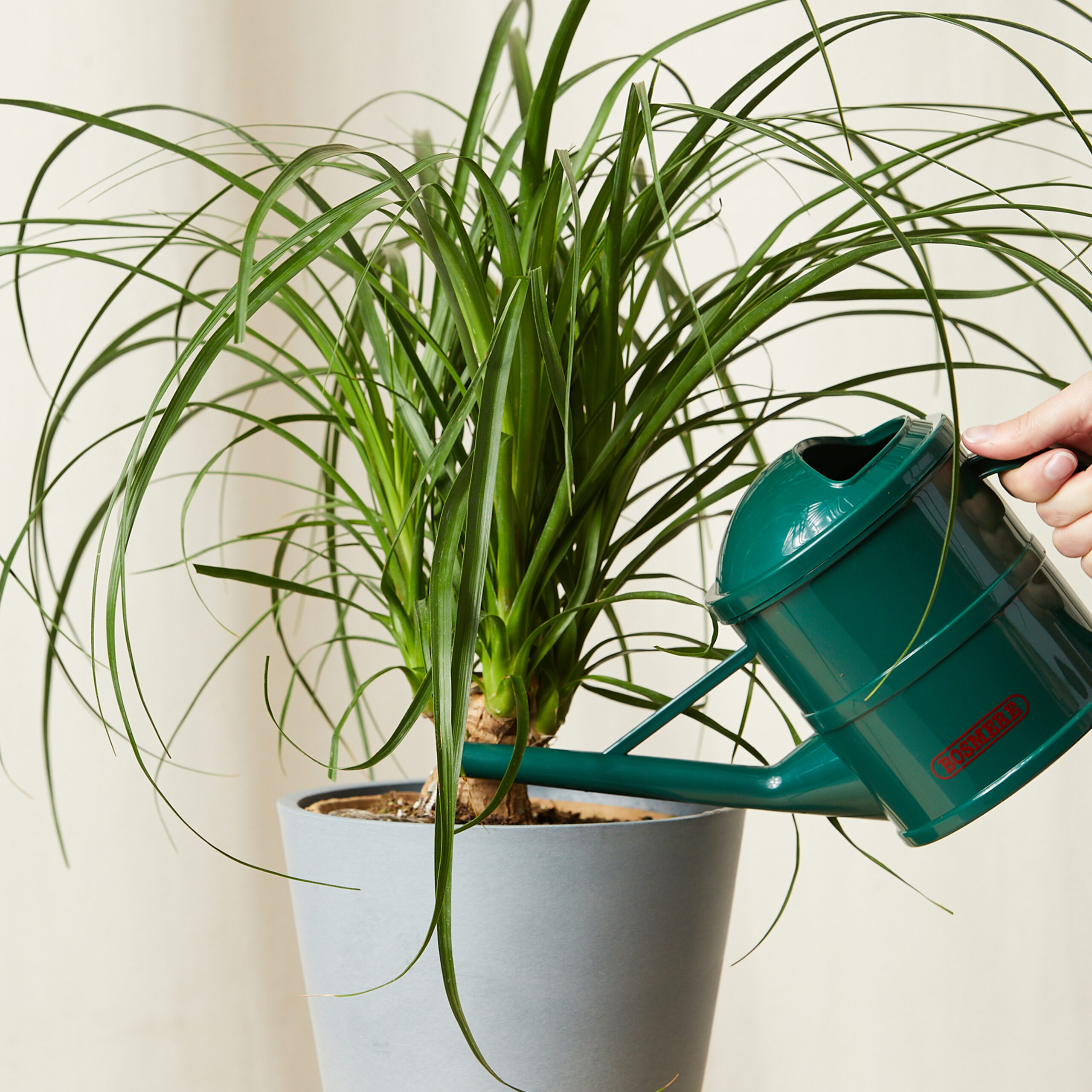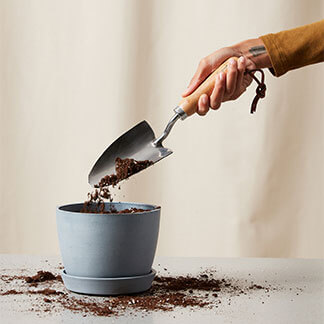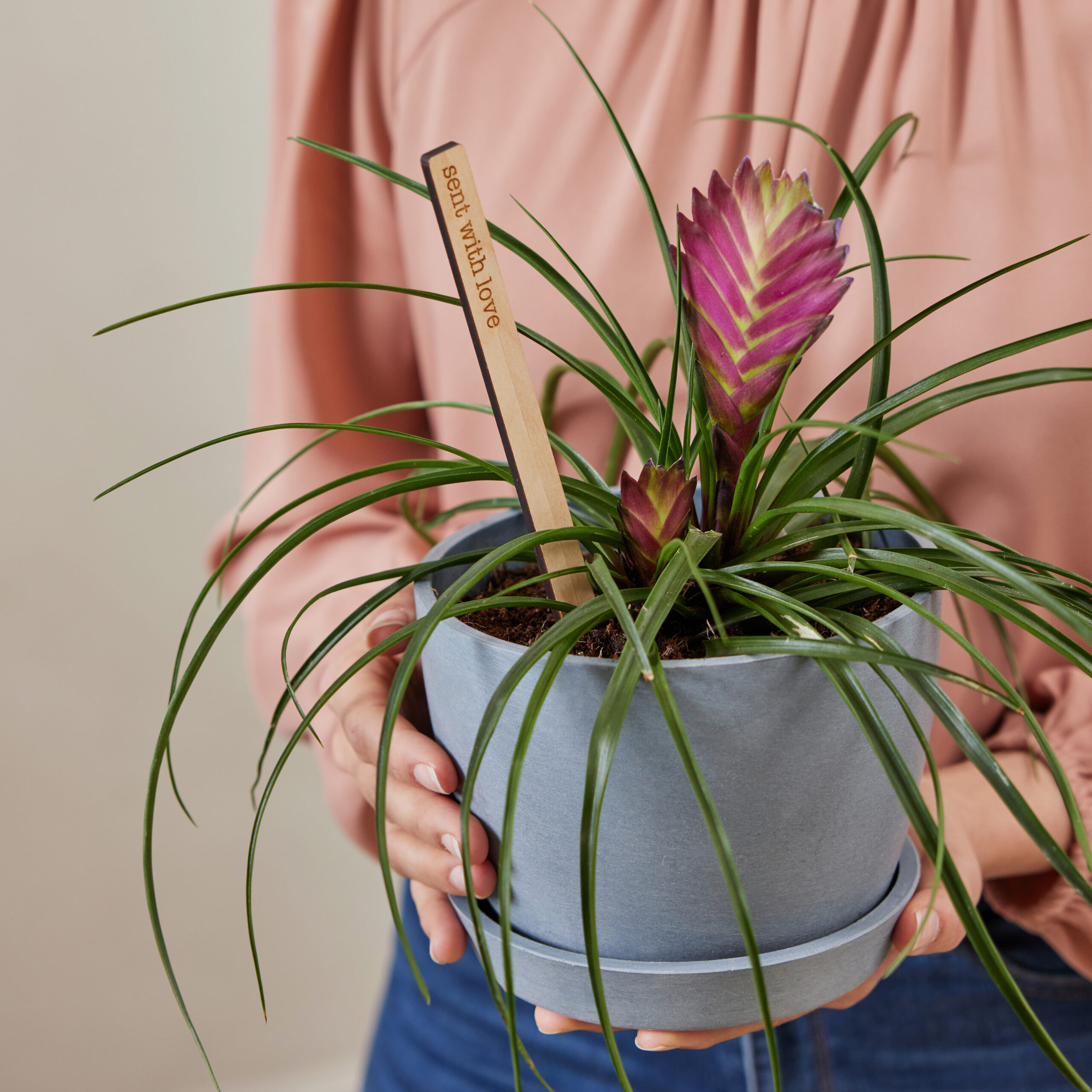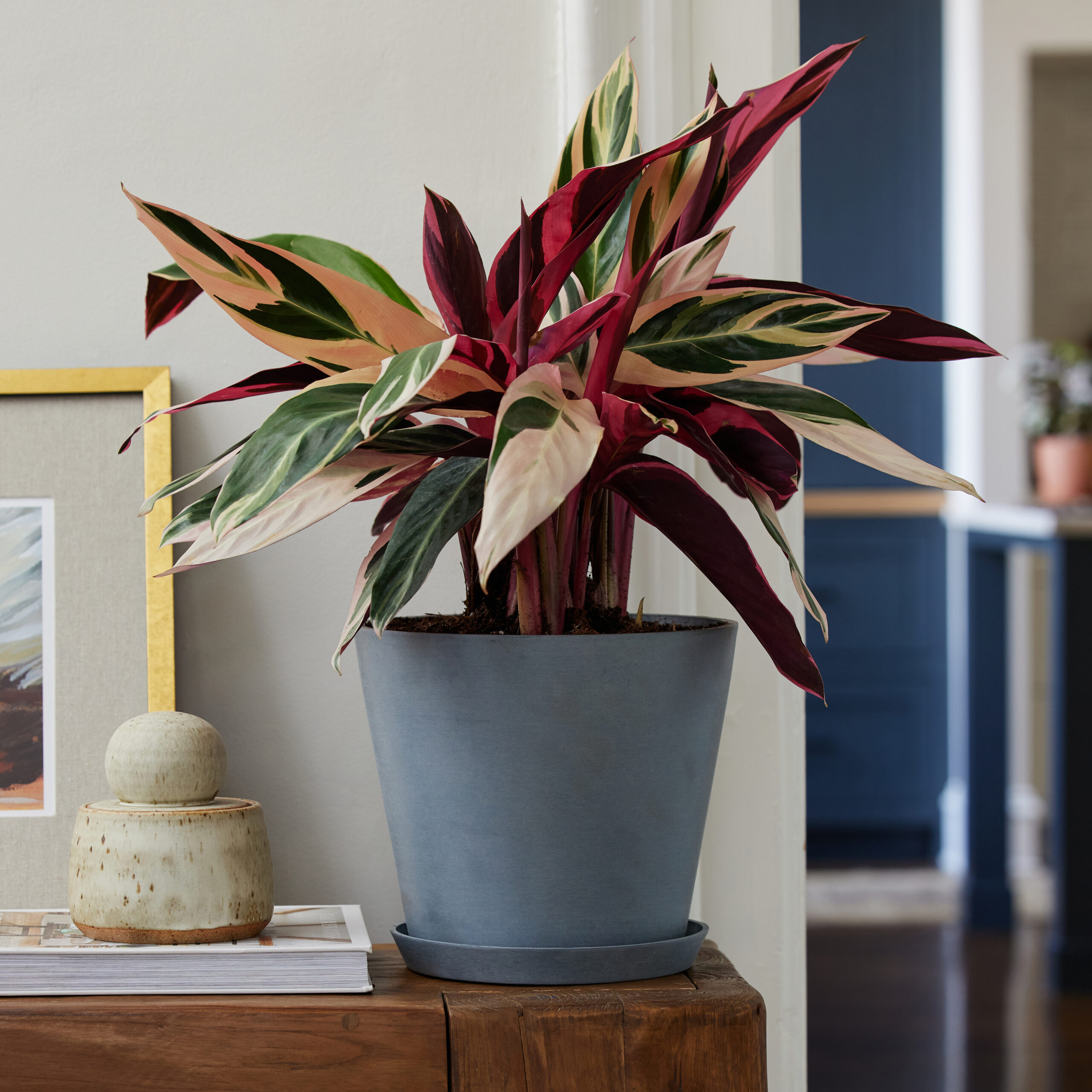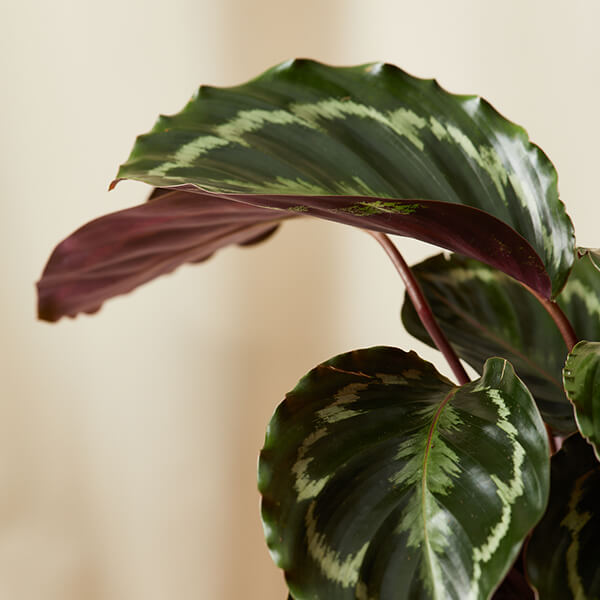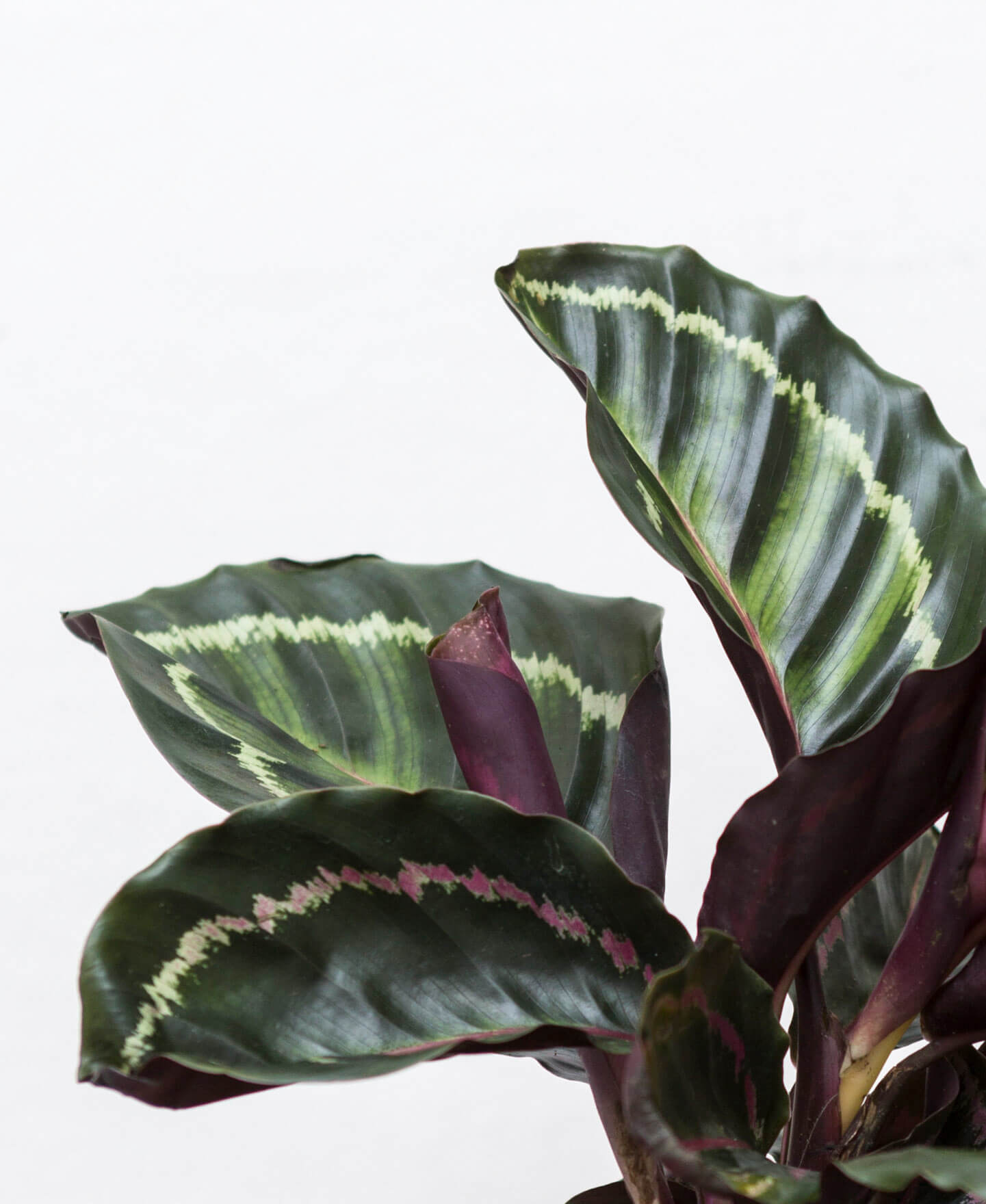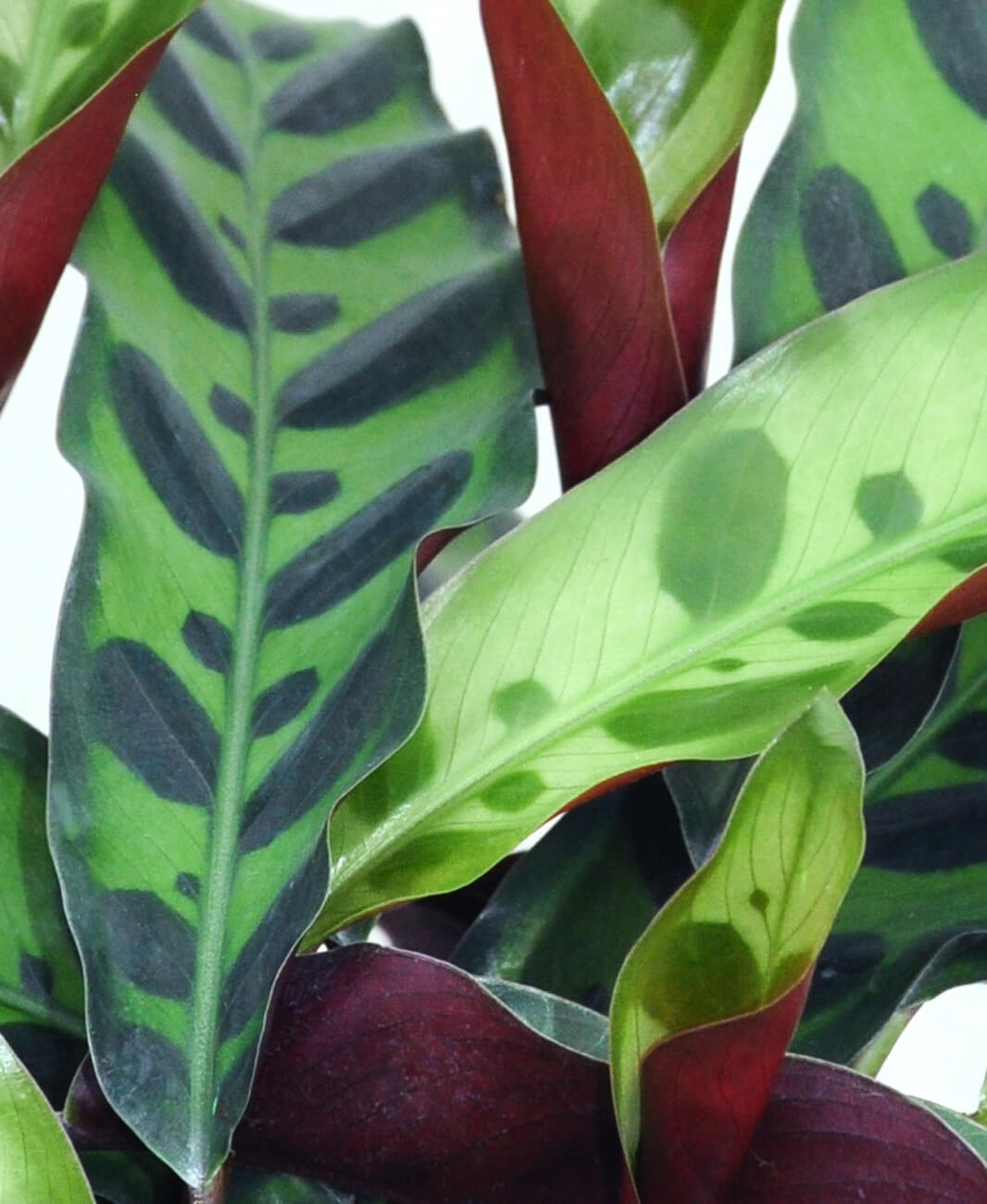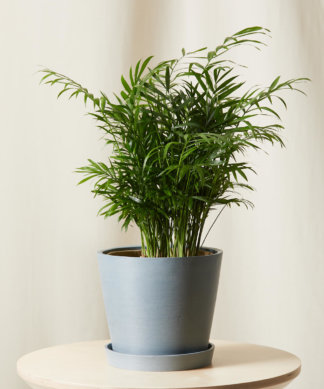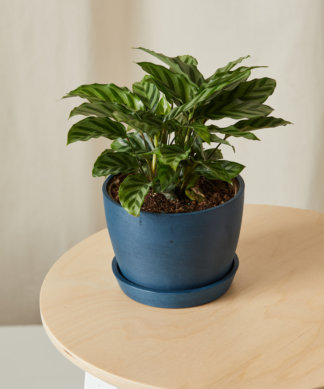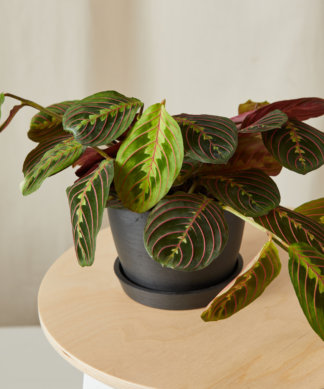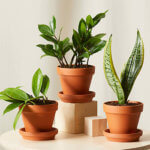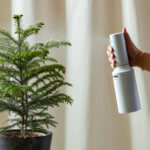How to care for your Calathea
Use these instructions to care for a Calathea. This guide will tell you how to water a Calathea; its light, temperature, humidity preferences and any additional care it might need to help it grow.
Calathea Beauty Star
Your Calathea Beauty Star prefers medium to bright indirect light—so placing it in front of an east, west, or north window is ideal. Direct sun burns the leaves and causes the beautiful leaf colors to fade.
Water your Calathea when the top 25% of soil is dry. Water until liquid flows through the drainage hole at the bottom of the pot and discard any water that has accumulated in the saucer.
Like many tropical indoor plants, your Beauty Star prefers a spot with ample humidity. Brown edges on the leaves indicate the air is too dry. Mist often, add a pebble tray, or place a humidifier nearby.
Your Beauty Start enjoys the warmth, preferably between 65-85 degrees. Maintain indoor temperatures above 60 degrees and avoid cold drafts and sudden temperature changes.
For best results, use a general houseplant fertilizer every four weeks during the spring and summer. No fertilizer is necessary during the winter when plant growth naturally slows.
Your Calathea Beauty Star is non-toxic to cats, dogs, and humans.
If you notice a tip or edges of your Beauty Star are burned, often with a yellowish hue, it could be due to your tap water. To solve this, use distilled water, rainwater, or allow your tap water to stand overnight before watering so the chlorine and fluoride can evaporate. Remove any yellow leaves to keep your plant strong and growing. Do not use any shine products on the leaves, instead, clean leaves occasionally with a damp cloth.
Calathea Dottie
Your Calathea will do best in medium to bright indirect light, but will tolerate lower light situations. Don’t allow this plant to receive direct sunlight as the leaves will burn.
Water your Calathea when the top 25% of soil is dry. Water until liquid flows through the drainage hole at the bottom of the pot and discard any water that has accumulated in the saucer.
Like many tropical indoor plants, your Calathea prefers a spot with ample humidity. If leaf edges begin to curl or brown up, mist them with lukewarm water on a regular basis, add a pebble tray, or place a humidifier nearby. Your bathroom or kitchen are perfect spots for your Calathea because these areas tend to be more humid.
Your Calathea prefers average room temperatures between 60-80 degrees. It will not tolerate temperatures below 55 degrees. It is also sensitive to cold drafts or blowing heat during the winter months, so keep it away from windows and heaters for best results.
Feed your Calathea Dottie with a general houseplant fertilizer every month during spring and summer. No fertilizer is necessary in the winter when plant growth naturally slows.
Your Calathea Dottie is non-toxic and pet-friendly.
If you notice the tips or edges of your Calathea Dottie’s leaves are turning brown, often with a yellowish hue at the edge, it could be due to your tap water. Allow your tap water to sit out overnight before watering so the chlorine and fluoride can evaporate. Alternatively, you can water with filtered water or rainwater. Remove any yellow leaves to keep your plant strong and growing.
Calathea Freddie
Your Freddie Plant prefers medium to bright indirect light—so placing it in front of an east, west, or north window is ideal. Too much direct sun burns the leaves and causes the beautiful leaf colors to fade.
Water your Calathea when the top 25% of soil is dry. Water until liquid flows through the drainage hole at the bottom of the pot and discard any water that has accumulated in the saucer.
Like many tropical indoor plants, your Calathea Freddie prefers a spot with ample humidity. Brown edges on the leaves indicate the air is too dry. Mist often, add a pebble tray, or place a humidifier nearby.
This plant enjoys the warmth, preferably between 65-85 degrees. Maintain indoor temperatures above 60 degrees and avoid cold drafts and sudden temperature changes.
For best results, use a general houseplant fertilizer with iron every four weeks during the spring and summer. No fertilizer is necessary during the winter when plant growth naturally slows.
The Freddie Plant is non-toxic to cats, dogs, and humans.
If you notice a tip or edge burn often with a yellowish hue at the edge, especially on older leaves, it could be due to your tap water. To solve this, use distilled water, rainwater, or allow your tap water to stand overnight before watering so the chlorine and fluoride can evaporate. Remove any yellow leaves to keep your plant strong and growing. Do not use any shine products on the leaves, instead, clean leaves occasionally with a damp cloth.
Calathea Medallion
Your Calathea Medallion will do best in medium to bright indirect light, but will tolerate lower light situations. Never allow this plant to stand in the direct sunlight—the leaves will get sunburned!
Water your Calathea when the top 25% of soil is dry. Water until liquid flows through the drainage hole at the bottom of the pot and discard any water that has accumulated in the saucer.
Like many tropical indoor plants, your Calathea Medallion prefers a spot with ample humidity. If leaf edges begin to curl or brown up, mist them with lukewarm water on a regular basis, use a pebble tray, or place a humidifier nearby. Your bathroom or kitchen are perfect spots for this plant because these areas tend to be more humid.
Your Calathea Medallion enjoys warmth, preferably between 65-85 degrees, so maintain indoor temperatures above 60 degrees. Avoid cold drafts and sudden temperature changes.
For best results, use a general houseplant fertilizer with iron every four weeks during the spring and summer. No fertilizer is necessary for the winter when plant growth naturally slows.
Calatheas are non-poisonous plants and are safe for humans, cats, and dogs.
If you notice a tip or edges of your Calathea Medallion are burned, often with a yellowish hue, it could be due to your tap water. To solve this, use distilled water, rainwater, or allow your tap water to stand overnight before watering so the chlorine and fluoride can evaporate. Remove any yellow leaves to keep your plant strong and growing. Do not use any shine products on the leaves, instead, clean leaves occasionally with a damp cloth.
Calathea Misto
Your Calathea Misto will do best in low to medium light. Never allow your plant to stand in the direct sunlight—the leaves will burn.
Water your Calathea when the top 25% of soil is dry. Water until liquid flows through the drainage hole at the bottom of the pot and discard any water that has accumulated in the saucer.
Like many tropical indoor plants, your Calathea Misto prefers a spot with ample humidity. If leaf edges begin to curl or brown up, mist them with lukewarm water on a regular basis, use a pebble tray, or place a humidifier nearby. Your bathroom or kitchen are perfect spots for this plant because these areas tend to be more humid.
Maintain indoor temperatures above 60 degrees, as your Calathea Misto enjoys the warmth–preferably between 65-85 degrees. Avoid cold drafts and sudden temperature changes.
For best results, use a general houseplant fertilizer every four weeks during the spring and summer. No fertilizer is necessary for the winter when plant growth naturally slows. Make sure to apply fertilizer to damp soil-never dry, as it will burn the plants’ roots.
Your Calathea Misto is a non-poisonous plant and is safe for humans, cats, and dogs.
If you notice a tip or edges of your Calathea Misto are burned, often with a yellowish hue, it could be due to your tap water. To solve this, use distilled water, rainwater, or allow your tap water to stand overnight before watering so the chlorine and fluoride can evaporate. Remove any yellow leaves to keep your plant strong and growing. Do not use any shine products on the leaves, instead, clean leaves occasionally with a damp cloth.
Calathea Musaica
Your Calathea Musaica will do best in low to bright indirect light. Never allow this plant to receive direct sunlight–the foliage will burn.
Water your Calathea when the top 25% of soil is dry. Water until liquid flows through the drainage hole at the bottom of the pot and discard any water that has accumulated in the saucer.
Like many tropical indoor plants, your Calathea prefers a spot with ample humidity. If leaf edges begin to curl or brown up, mist them with lukewarm water on a regular basis, use a pebble tray, or place a humidifier nearby. Your bathroom or kitchen are perfect spots for this plant because these areas tend to be more humid.
Your Calathea Musaica prefers average room temperature, from 60-80 degrees. They are sensitive to cold drafts and blowing heat during the winter months, so keep them away from windows and heaters for best results.
Use a general houseplant fertilizer diluted to half the recommended strength every month during spring and summer. No fertilizer is necessary in the winter when plant growth naturally slows.
Your Calathea Musaica is non-toxic and pet-friendly.
If you notice a tip or edges of your Calathea Musaica are burned, often with a yellowish hue, it could be due to your tap water. To solve this, use distilled water, rainwater, or allow your tap water to stand overnight before watering so the chlorine and fluoride can evaporate. Remove any yellow leaves to keep your plant strong and growing. Do not use any shine products on the leaves, instead, clean leaves occasionally with a damp cloth.
Goeppertia orbifolia
Calatheas prefer low to indirect bright light. The more indirect light they receive the bolder their colors will be. Keep away from direct light as it can burn the leaves.
Water your calathea when 25% of the soil volume is dry. Water thoroughly and discard excess water from the saucer.
Calatheas prefer a humid environment. Dry crispy leaves indicate the air is too dry. Add a pebble tray or place a humidifier nearby.
This plant enjoys warmth, preferably between 65-85°F. Maintain indoor temperatures above 60°F and avoid cold drafts and sudden temperature changes.
For best results, use a general houseplant fertilizer once a month during the spring and summer. No fertilizer is necessary during the winter when plant growth naturally slows.
Calatheas are non-toxic to humans and pets if ingested.
If you notice a leaf tip or edge burn often with a yellowish hue at the edge, especially on older leaves, it could be due to your tap water. To solve this, use distilled water or rainwater. Remove any yellow leaves to keep your plant strong and growing. Do not use any shine products on the leaves, instead, clean leaves occasionally with a damp cloth.
Calathea Peacock
Calatheas prefer low to indirect bright light. The more indirect light they receive the bolder their colors will be. Keep away from direct light as it can burn the leaves.
Water your calathea when 25% of the soil volume is dry. Water thoroughly and discard excess water from the saucer.
Calatheas prefer a humid environment. Dry crispy leaves indicate the air is too dry. Add a pebble tray or place a humidifier nearby.
This plant enjoys warmth, preferably between 65-85°F. Maintain indoor temperatures above 60 degrees and avoid cold drafts and sudden temperature changes.
For best results, use a general houseplant fertilizer with iron every four weeks during the spring and summer. No fertilizer is necessary for the winter when plant growth naturally slows.
Calatheas are non-toxic to humans and pets if ingested.
If you notice a leaf tip or edge burn often with a yellowish hue at the edge, especially on older leaves, it could be due to your tap water. To solve this, use distilled water or rainwater. Remove any yellow leaves to keep your plant strong and growing. Do not use any shine products on the leaves, instead, clean leaves occasionally with a damp cloth.
Calathea Pinstripe
Calatheas prefer low to indirect bright light. The more indirect light they receive the bolder their colors will be. Keep away from direct light as it can burn the leaves.
Water your calathea when 25% of the soil volume is dry. Water thoroughly and discard excess water from the saucer.
Calatheas prefer a humid environment. Dry crispy leaves indicate the air is too dry. Add a pebble tray or place a humidifier nearby.
This plant enjoys warmth, preferably between 65-85°F. Maintain indoor temperatures above 60°F and avoid cold drafts and sudden temperature changes.
For best results, use a general houseplant fertilizer once a month during the spring and summer. No fertilizer is necessary during the winter when plant growth naturally slows.
Calatheas are non-toxic to humans and pets if ingested.
If you notice a leaf tip or edge burn often with a yellowish hue at the edge, especially on older leaves, it could be due to your tap water. To solve this, use distilled water or rainwater. Remove any yellow leaves to keep your plant strong and growing. Do not use any shine products on the leaves, instead, clean leaves occasionally with a damp cloth.
Calathea Rattlesnake
Calatheas prefer low to indirect bright light. The more indirect light they receive the bolder their colors will be. Keep away from direct light as it can burn the leaves.
Water your calathea when 25% of the soil volume is dry. Water thoroughly and discard excess water from the saucer.
Calatheas prefer a humid environment. Dry crispy leaves indicate the air is too dry. Add a pebble tray or place a humidifier nearby.
This plant enjoys warmth, preferably between 65-85°F. Maintain indoor temperatures above 60°F and avoid cold drafts and sudden temperature changes.
For best results, use a general houseplant fertilizer once a month during the spring and summer. No fertilizer is necessary during the winter when plant growth naturally slows.
Calatheas are non-toxic to humans and pets if ingested.
If you notice a leaf tip or edge burn often with a yellowish hue at the edge, especially on older leaves, it could be due to your tap water. To solve this, use distilled water or rainwater. Remove any yellow leaves to keep your plant strong and growing. Do not use any shine products on the leaves, instead, clean leaves occasionally with a damp cloth.
Calathea Rosy Roseo
Your Calathea Rosy Roseo will do best in medium to low indirect light. Never allow this plant to receive direct sunlight, the leaves will burn.
Water your Calathea when the top 25% of soil is dry. Water until liquid flows through the drainage hole at the bottom of the pot and discard any water that has accumulated in the saucer.
Like many tropical indoor plants, your Calathea Rosy Roseo prefers a spot with ample humidity. If leaf edges begin to curl or brown up, mist them with lukewarm water on a regular basis, use a pebble tray, or place a humidifier nearby. Your bathroom or kitchen are perfect spots for this plant because these areas tend to be more humid.
Your Calathea Rosy Roseo prefers average room temperature, from 60-80 degrees. They are sensitive to cold drafts and blowing heat during the winter months, so keep them away from windows and heaters for best results.
Use a general houseplant fertilizer diluted to half the recommended strength every month during spring and summer. No fertilizer is necessary in the winter when plant growth naturally slows.
Your Calathea Rosy Roseo is non-toxic and pet-friendly.
If you notice a tip or edges of your Calathea are burned, often with a yellowish hue, it could be due to your tap water. To solve this, use distilled water, rainwater, or allow your tap water to stand overnight before watering so the chlorine and fluoride can evaporate. Remove any yellow leaves to keep your plant strong and growing. Do not use any shine products on the leaves, instead, clean leaves occasionally with a damp cloth.
Calathea Stella
Your Calathea prefers medium to bright indirect light. It can adapt to low light, but growth will slow. Extended periods of direct sunlight can scorch the leaves.
Water when 25% of the soil volume is dry. Add water slowly, allowing it to soak into the soil until it flows through the drainage hole. Discard water that accumulates in the saucer.
This plant prefers above-average household humidity. Try adding a pebble tray, grouping it with other plants, or placing a humidifier nearby.
Your Calathea prefers temperatures between 65-85°F.
Feed monthly during periods of active growth with an all-purpose fertilizer for indoor plants, diluted to half strength. Never apply fertilizer to dry soil.
This plant is considered non-toxic and pet-friendly.
Dry brown leaf edges, often highlighted with a yellow band, can signal fluoride toxicity from tap water. If you notice this, switch to water that does not contain fluoride, like distilled or rainwater.
Calathea Vittata
Your Calathea will do best in medium to low indirect light. Never allow this plant to receive direct sunlight, the leaves will burn.
Water your Calathea when the top 25% of soil is dry. Water until liquid flows through the drainage hole at the bottom of the pot and discard any water that has accumulated in the saucer.
Like many tropical indoor plants, your Calathea prefers a spot with ample humidity. If leaf edges begin to curl or brown up, mist them with lukewarm water on a regular basis, use a pebble tray, or place a humidifier nearby. Your bathroom or kitchen are perfect spots for this plant because these areas tend to be more humid.
Your Calathea prefers average room temperature, from 60-80 degrees F. They will not tolerate temperatures below 55 degrees. They are also sensitive to cold drafts or blowing heat during the winter months, so keep them away from windows or heaters for best results.
For best results, use a general houseplant fertilizer every month during spring and summer. No fertilizer is necessary in the winter when plant growth naturally slows.
Calathea are non-toxic and pet-friendly.
If you notice a tip or edges of your Calathea Vittata are burned, often with a yellowish hue, it could be due to your tap water. To solve this, use distilled water, rainwater, or allow your tap water to stand overnight before watering so the chlorine and fluoride can evaporate. Remove any yellow leaves to keep your plant strong and growing. Do not use any shine products on the leaves, instead, clean leaves occasionally with a damp cloth.
Calathea White Flame
Your Calathea will do best in medium to bright indirect light, but will tolerate lower light situations. Avoid placing this plant in direct sunlight as it will scorch the leaves.
Water your Calathea when the top 25-50% of soil is dry. This is not a drought-tolerant indoor plant, but it is relatively forgiving if you forget to water it from time to time. Extended periods of dryness can result in brown leaf tips or edges.
Like many tropical indoor plants, your Calathea prefers a spot with ample humidity. If leaf edges begin to curl or brown up, mist them with lukewarm water on a regular basis, use a pebble tray, or place a humidifier nearby. Your bathroom or kitchen are perfect spots for this plant because these areas tend to be more humid.
Your Calathea prefers average room temperatures between 60-80 degrees. It will not tolerate temperatures below 55 degrees. It is also sensitive to cold drafts or blowing heat during the winter months, so be sure to place it away from windows and heaters.
Feed your Calathea White Flame with a general houseplant fertilizer every month during spring and summer. No fertilizer is necessary in the winter when plant growth naturally slows.
Your Calathea White Flame is non-toxic and pet-friendly.
If you notice a tip or edges of your Calathea are burned, often with a yellowish hue, it could be due to your tap water. To solve this, use distilled water, rainwater, or allow your tap water to stand overnight before watering so the chlorine and fluoride can evaporate. Remove any yellow leaves to keep your plant strong and growing. Do not use any shine products on the leaves, instead, clean leaves occasionally with a damp cloth.
Calathea Zebra
Your Calathea Zebra will do best in medium to low indirect light. Never allow your plant to receive direct sunlight, as the leaves will burn.
Water your Calathea when the top 25% of soil is dry. Water until liquid flows through the drainage hole at the bottom of the pot and discard any water that has accumulated in the saucer.
Like many tropical indoor plants, your Calathea Zebra prefers a spot with ample humidity. If leaf edges begin to curl or brown up, mist them with lukewarm water on a regular basis, use a pebble tray, or place a humidifier nearby. Your bathroom or kitchen are perfect spots for this plant because these areas tend to be more humid.
Your Calathea Zebra prefers average room temperatures from 60-80 degrees. They are sensitive to cold drafts and blowing heat during the winter months, so keep them away from windows and heaters for best results.
Use a general houseplant fertilizer every month during the spring and summer. No fertilizer is necessary in the winter when plant growth naturally slows.
Your Calathea Zebra is non-toxic and pet-friendly.
If you notice a tip or edges of your Calathea Zebra are burned, often with a yellowish hue, it could be due to your tap water. To solve this, use distilled water, rainwater, or allow your tap water to stand overnight before watering so the chlorine and fluoride can evaporate. Remove any yellow leaves to keep your plant strong and growing. Do not use any shine products on the leaves, instead, clean leaves occasionally with a damp cloth.
